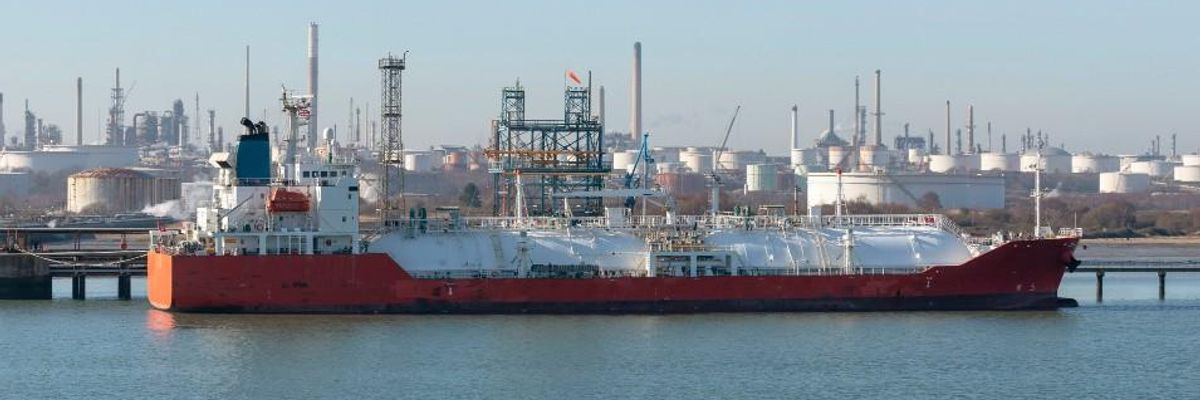

SUBSCRIBE TO OUR FREE NEWSLETTER
Daily news & progressive opinion—funded by the people, not the corporations—delivered straight to your inbox.
5
#000000
#FFFFFF
To donate by check, phone, or other method, see our More Ways to Give page.


Daily news & progressive opinion—funded by the people, not the corporations—delivered straight to your inbox.

A fossil fuel ship is seen near the Port of Southampton in the United Kingdom. (Photo: Peter Titmuss/Education Images/Universal Images Group via Getty Images)
A boom in U.S. liquefied natural gas exports driven by Russia's invasion of Ukraine could add a staggering 90 million tons or more of planet-heating greenhouse gases annually, a report published Thursday revealed.
"A dramatic increase in global dependence on LNG could be risky, from a climate perspective."
The Environmental Integrity Project (EIP) publication--entitled Playing With Fire: The Climate Impact of the Rapid Growth of LNG--notes that the United States went from exporting no liquefied natural gas in 2015 to becoming one of the world's leading LNG exporters by 2021.
Now, with the Russian invasion causing "unprecedented supply disruptions" and driving fuel prices to record levels in much of the world, the paper says the U.S. is soon expected to lead the world in LNG export capacity.
The report notes that this gas export boom "will have a significant environmental impact," as 25 LNG construction or expansion projects in the U.S., including four new terminals being built in Texas and Louisiana, "could emit more than 90 million tons of greenhouse gases per year."
"That's almost as much climate-warming pollution as 18 million passenger vehicles running for a year--more than from all the cars and trucks in Florida or New York state," the paper says.
These potential greenhouse gas impacts "would only come from operating the LNG terminals themselves," the report notes. "They do not include emissions from drilling and hydraulic fracturing, or the eventual burning of gas in homes and businesses. If these upstream and downstream contributions are accounted for, the true climate footprint of LNG would be several times higher."
Alexandra Shaykevich, research manager at EIP, said in a statement that "a dramatic increase in global dependence on LNG could be risky, from a climate perspective."
"Although there is pressure to hurry up approvals of these LNG projects," she added, "government regulators should be careful and thoughtful in considering their significant environmental impacts."
The EIP report was released the day after an explosion rocked a major liquefied natural gas plant in Texas.
Related Content

The new analysis also follows a new Climate Action Tracker report detailing how, instead of heeding progressive calls to accelerate a global clean energy transition, policymakers are expanding fossil fuel production amid a worldwide "gold rush" in gas production, pipelines, and LNG facilities.
Dear Common Dreams reader, The U.S. is on a fast track to authoritarianism like nothing I've ever seen. Meanwhile, corporate news outlets are utterly capitulating to Trump, twisting their coverage to avoid drawing his ire while lining up to stuff cash in his pockets. That's why I believe that Common Dreams is doing the best and most consequential reporting that we've ever done. Our small but mighty team is a progressive reporting powerhouse, covering the news every day that the corporate media never will. Our mission has always been simple: To inform. To inspire. And to ignite change for the common good. Now here's the key piece that I want all our readers to understand: None of this would be possible without your financial support. That's not just some fundraising cliche. It's the absolute and literal truth. We don't accept corporate advertising and never will. We don't have a paywall because we don't think people should be blocked from critical news based on their ability to pay. Everything we do is funded by the donations of readers like you. Will you donate now to help power the nonprofit, independent reporting of Common Dreams? Thank you for being a vital member of our community. Together, we can keep independent journalism alive when it’s needed most. - Craig Brown, Co-founder |
A boom in U.S. liquefied natural gas exports driven by Russia's invasion of Ukraine could add a staggering 90 million tons or more of planet-heating greenhouse gases annually, a report published Thursday revealed.
"A dramatic increase in global dependence on LNG could be risky, from a climate perspective."
The Environmental Integrity Project (EIP) publication--entitled Playing With Fire: The Climate Impact of the Rapid Growth of LNG--notes that the United States went from exporting no liquefied natural gas in 2015 to becoming one of the world's leading LNG exporters by 2021.
Now, with the Russian invasion causing "unprecedented supply disruptions" and driving fuel prices to record levels in much of the world, the paper says the U.S. is soon expected to lead the world in LNG export capacity.
The report notes that this gas export boom "will have a significant environmental impact," as 25 LNG construction or expansion projects in the U.S., including four new terminals being built in Texas and Louisiana, "could emit more than 90 million tons of greenhouse gases per year."
"That's almost as much climate-warming pollution as 18 million passenger vehicles running for a year--more than from all the cars and trucks in Florida or New York state," the paper says.
These potential greenhouse gas impacts "would only come from operating the LNG terminals themselves," the report notes. "They do not include emissions from drilling and hydraulic fracturing, or the eventual burning of gas in homes and businesses. If these upstream and downstream contributions are accounted for, the true climate footprint of LNG would be several times higher."
Alexandra Shaykevich, research manager at EIP, said in a statement that "a dramatic increase in global dependence on LNG could be risky, from a climate perspective."
"Although there is pressure to hurry up approvals of these LNG projects," she added, "government regulators should be careful and thoughtful in considering their significant environmental impacts."
The EIP report was released the day after an explosion rocked a major liquefied natural gas plant in Texas.
Related Content

The new analysis also follows a new Climate Action Tracker report detailing how, instead of heeding progressive calls to accelerate a global clean energy transition, policymakers are expanding fossil fuel production amid a worldwide "gold rush" in gas production, pipelines, and LNG facilities.
A boom in U.S. liquefied natural gas exports driven by Russia's invasion of Ukraine could add a staggering 90 million tons or more of planet-heating greenhouse gases annually, a report published Thursday revealed.
"A dramatic increase in global dependence on LNG could be risky, from a climate perspective."
The Environmental Integrity Project (EIP) publication--entitled Playing With Fire: The Climate Impact of the Rapid Growth of LNG--notes that the United States went from exporting no liquefied natural gas in 2015 to becoming one of the world's leading LNG exporters by 2021.
Now, with the Russian invasion causing "unprecedented supply disruptions" and driving fuel prices to record levels in much of the world, the paper says the U.S. is soon expected to lead the world in LNG export capacity.
The report notes that this gas export boom "will have a significant environmental impact," as 25 LNG construction or expansion projects in the U.S., including four new terminals being built in Texas and Louisiana, "could emit more than 90 million tons of greenhouse gases per year."
"That's almost as much climate-warming pollution as 18 million passenger vehicles running for a year--more than from all the cars and trucks in Florida or New York state," the paper says.
These potential greenhouse gas impacts "would only come from operating the LNG terminals themselves," the report notes. "They do not include emissions from drilling and hydraulic fracturing, or the eventual burning of gas in homes and businesses. If these upstream and downstream contributions are accounted for, the true climate footprint of LNG would be several times higher."
Alexandra Shaykevich, research manager at EIP, said in a statement that "a dramatic increase in global dependence on LNG could be risky, from a climate perspective."
"Although there is pressure to hurry up approvals of these LNG projects," she added, "government regulators should be careful and thoughtful in considering their significant environmental impacts."
The EIP report was released the day after an explosion rocked a major liquefied natural gas plant in Texas.
Related Content

The new analysis also follows a new Climate Action Tracker report detailing how, instead of heeding progressive calls to accelerate a global clean energy transition, policymakers are expanding fossil fuel production amid a worldwide "gold rush" in gas production, pipelines, and LNG facilities.